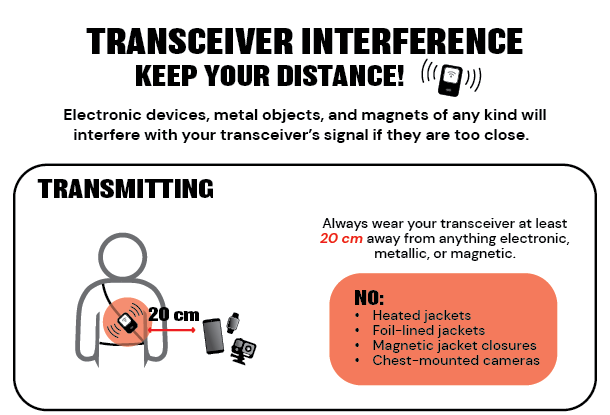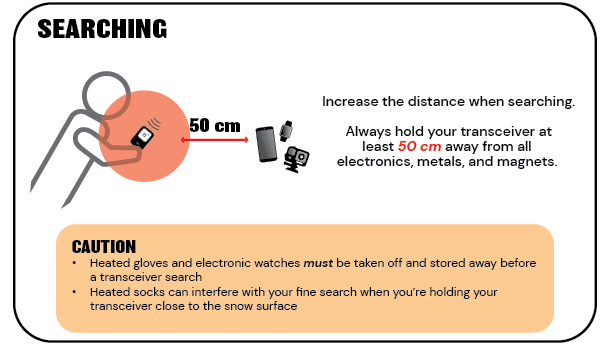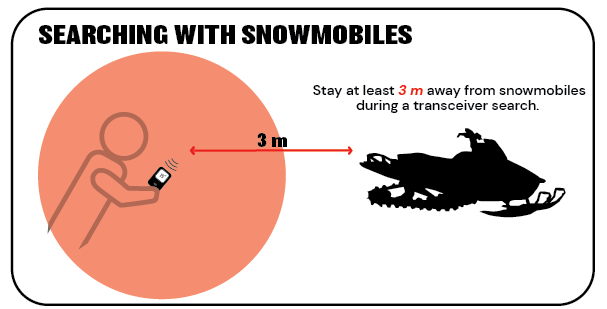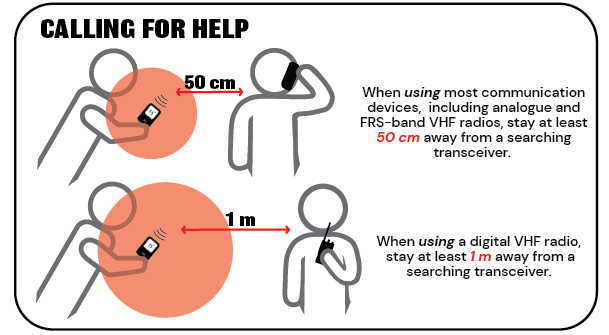
Mark Staples
2015-2024 - Director, Forest Service Utah Avalanche Center
Avalanche transceivers are susceptible to interference by electronic devices, metal objects, and magnets if they are too close. Every day there are more electronic devices being carried into the backcountry. Of particular concern may be heated clothing.
The guidance below provides practical guidance on how to avoid problems with interference. It was created through a collaboration by Avalanche Canada, the US National Avalanche Center, Colorado Avalanche Information Center, Utah Avalanche Center, Northwest Avalanche Center and the six avalanche transceiver manufacturers: Arva, BCA, Black Diamond, Mammut, Orthovox and Pieps. Thanks to Avalanche Canda for creating the images below!
There are two scenarios in which interference may occur:
- Interference with a transmitting transceiver (send mode). This must be addressed and dealt with before going into the backcountry. If you are buried and wearing something causing interference, you will not be able to fix the situation.
- Interference with a receiving transceiver (search mode). This one should also be addressed and fixed before going into the backcountry; however, if a searcher can recognize interference is happening during a search, they would have an opportunity to deal with it as long as they can accurately recognize the interference.
Interference with transceivers generally presents as either reduced range or ghost signals.
The GOOD NEWS is that interference has a simple solution - DISTANCE. Add distance between the transceiver and the object creating interference. The guidance below will help you understand how much distance you need.
The 20/50 rule is that you want your beacon 20cm (8") away from other electronics while transmitting and 50cm (20") away from electronics while searching.






Wow! Great info. This material is being asked about, and talked about more and more as technology and clothing combine. Next, heated jackets.
Michael Davis (not verified)
Tue, 2/7/2023
- reply
It had not occurred to me to take off my bluetooth connected GPS watch.
I seem to remember old transceivers being mounted on the center of your chest. Now the tend to be lower left abdomen. 20cm away from a pacemaker.
Thanks for the information
Pete Freeman (not verified)
Sun, 2/19/2023
Great information, if you have a link to more detail about how the interference was tested I'd be curious. I did my own backyard tests a couple of years ago using a Mammut Barryvox S and a Mammut Element beacon. As expected, I saw major interference in search mode from an iPhone, seemingly about equal in magnitude between regular and airplane mode. Interestingly, I didn't see any difference in search mode when I held a transmitting radio right next to the beacon. I used both a BCA transmitting at 2W and a Baofeng at 5W. I had similar results when the electronics were next to the sending beacon. I found that quickly moving my phone to my back pocket created enough distance and the increased shielding from my body probably helped too. A friend and I have hypothesized that a clothing manufacturer could incorporate a Faraday pouch pocket into a touring pant that could eliminate any phone interference.
Steve (not verified)
Thu, 3/9/2023
Important subject. Thanks for discussing it even the recent avalanche fatality in Weber canyon had issues with ghost signals from a radio.
Everyone has a phone with them nowadays and many of us have FSR radios for communication as well. Some have additional go pro type devices that may use Bluetooth wifi etc as well.
So many bc skiers have 2-4 electronic devices on them most have at least 2. We’ve also talked about not using electric gloves and socks etc.
I think we should discuss the phone issue further as almost all will have one with them most often or if not they will have a Garmin mini Sat communication device.
A great solution and easy one is everyone should have their phone in a faraday bag to shield the screen as the article mentions but also with the phone on airplane mode to help preserve the battery life in case of emergency.
Great detailed article on faraday bag use for off piste backcountry skiing use from Alpine guides. Also with a suggested tested faraday bag recommendation as well.
II would suggest that Mark staples could update this article to also suggest the use of faraday bags as an additional solution to interference as well, understanding that the phone in the faraday bag still needs to be kept at least 20 cm or 8 inches away from your beacon transceiver. If you are buried you will certainly be happy that the phone is in a faraday bag not interfering at all with your beacon so the searchers can find you as quickly as possible.
https://www.alpine-guides.com/faraday-pouches-a-solution-for-electronic-shielding-whilst-off-piste-skiing/
Also another Faraday bag option to check out here locally in SLC area. Or online. I have no connection to any of these.
https://wndr-alpine.com/products/slnt-x-wndr-faraday-phone-sleeve
Michael Thomas (not verified)
Thu, 4/13/2023
A side note on the alpine guides article I just posted to you on faraday bags or pouches is that they did some testing on them and have some recommendations based on the testing that they did.
I haven’t investigated the other link I posted about the local company’s faraday but you could follow up on that to see if it’s double shielded or has 2 layers of shielding as the alpine guides article testing suggested.
Their website says it has multi shielding so it appears to be what we are looking for and here locally as well. Just $29 aprox plus shipping etc. Or we could possibly just pick them up
Michael C# 801-560-0149
Or my email
[email protected]
https://wndr-alpine.com/products/slnt-x-wndr-faraday-phone-sleeve
Michael Thomas (not verified)
Fri, 4/14/2023
By the way great article Mark!
Thanks so much for putting it together for education and opening up the conversation. Really appreciate what you guys do. ✅
Michael T Thomas (not verified)
Fri, 4/14/2023
Tests for the SLNT WNDR Faraday bag mentioned from my other email.
https://slnt.com/blogs/news/do-faraday-bags-work-these-4-tests-reveal-the-truth
Michael Thomas (not verified)
Fri, 4/14/2023
These Faraday seem nice.. yes they work, and they shield the phone signal. However, the risk of the body being contoured if buried and the farady blocking a transmitting beacon signal, even if in a different pocket, should be taken into account. Imho the risk does not outweigh the temporary benefit. I tested these years ago, you must be in airplane mode so the battery doesn't wear down, and you have to open and close to get your phone if you want a quick photo, but you might as well toss in your pack or turn it off if this is your major concern.
JJ (not verified)
Mon, 4/1/2024






